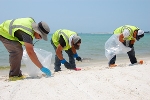Company says its blendstock has a lower Reid Vapor Pressure and will help urban areas comply with state-level ozone attainment plans.
Researchers Robert Jackson and Mark Little took core samples from four drinking water aquifers and discovered that some sites may be more conducive to carbon dioxide storage than others.
The contract includes munitions dating back 95 years and include those that contain mustard agent, phosgene, and other chemical agents.
The government's peer-reviewed reports say the levels of dioxins created during controlled burns were below levels of concern.
EPA's nutrient criteria rule is set to be finalized Sunday; recently elected Florida leaders want more time to analyze the rule's effect on residents.
The Home Energy Score will offer homeowners straightforward, reliable information about their homes' energy efficiency.
U.S. Energy Secretary Steven Chu traveled to New Orleans on Veterans Day, a national day of service, to volunteer at a home construction site with the St. Bernard Project, a group dedicated to creating ongoing housing opportunities for community residents in the wake of Hurricane Katrina.

Jocelyn K. Scheffler, who worked in the command center during the the Exxon oil spill cleanup, says many qualified emergency response and hazmat experts were excluded from the Gulf spill cleanup effort.

The heat radiating off roadways has long been a factor in explaining why city temperatures are often considerably warmer than nearby suburban or rural areas. Now a team of engineering researchers from the University of Rhode Island is examining methods of harvesting that solar energy to melt ice, power streetlights, illuminate signs, heat buildings and potentially use it for many other purposes.
The Vulnerability Self Assessment Tool and the Water Health and Economic Analysis Tool have been developed to help drinking water and other facilities assess their responses to threats and natural disasters.

U.S. Geological Survey scientists have not been able to isolate the cause of the highest rate of beak abnormalities ever recorded, particularly in birds in the Northwest and Alaska.
Facilities that emit more than 25,000 metric tons of carbon dioxide equivalent a year will have to monitor these releases and report to EPA.
Appleton applied technology from its security paper business to thermal receipt paper and expects to cover about 75 percent of its shipments by the end of November.
Indianapolis, Ind., conducted additional engineering studies and found that it could implement less expensive combined sewer overflow control measures to meet Clean Water Act regulations.

Rising temperatures decrease wind speeds, making for less power bang for the wind turbine buck.
Offshore Vessels pleaded guilty in July to charges that its crew knowingly discharged oily wastewater from the bilge tank.

Using a University of British Columbia-developed technology, Abrary and his team at Ostara Nutrient Recovery Technologies Inc., have managed to launch four full-scale facilities with two more in the design phase in just five years.
This section of the American Water Works Association has nearly 7,000 members.